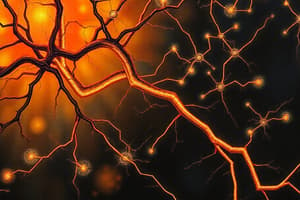Podcast
Questions and Answers
What is the function of the endocrine system?
What is the function of the endocrine system?
- Generating force and movement in the body
- Influencing target cells with chemical messengers (correct)
- Producing offspring
- Regulating muscle movement
Which type of muscles are responsible for the pumping action of the heart?
Which type of muscles are responsible for the pumping action of the heart?
- Skeletal muscles
- Cardiac muscles (correct)
- Smooth muscles
- Voluntary muscles
What is the primary role of the skeletal system?
What is the primary role of the skeletal system?
- Producing offspring
- Regulating various functions such as growth and development
- Providing support and protection to the body (correct)
- Generating force and movement in the body
Which system is responsible for the transportation and fertilization of gametes?
Which system is responsible for the transportation and fertilization of gametes?
What is a key aspect of biology that helps understand the functioning of living organisms?
What is a key aspect of biology that helps understand the functioning of living organisms?
Which system is responsible for controlling motor movements and maintaining homeostasis in the body?
Which system is responsible for controlling motor movements and maintaining homeostasis in the body?
What is the role of the spinal cord in the nervous system?
What is the role of the spinal cord in the nervous system?
Which part of the nervous system includes nerves that connect the brain and spinal cord to the rest of the body?
Which part of the nervous system includes nerves that connect the brain and spinal cord to the rest of the body?
What is the main function of the endocrine system?
What is the main function of the endocrine system?
Which system consists of a network of glands that secrete hormones directly into the bloodstream?
Which system consists of a network of glands that secrete hormones directly into the bloodstream?
Flashcards are hidden until you start studying
Study Notes
Biology Class 10: Control and Coordination
Introduction to Control and Coordination
Control and coordination is a crucial aspect of biology that plays a significant role in the proper functioning of organisms, their growth, and development. This topic is studied in biology class 10, where students learn about the various processes and mechanisms that enable living organisms to carry out their functions effectively.
Nervous System
The nervous system is a key component of control and coordination in biology. It is responsible for receiving and processing sensory information, controlling motor movements, and maintaining homeostasis in the body. The nervous system consists of the central nervous system (CNS) and the peripheral nervous system (PNS). The CNS includes the brain and the spinal cord, while the PNS includes nerves that connect the brain and spinal cord to the rest of the body.
The brain is responsible for controlling various functions such as breathing, heart rate, and body temperature. It receives sensory information from the sense organs, processes the information, and sends commands to the muscles and glands through the nervous system. The spinal cord, on the other hand, serves as a relay center and carries messages from the brain to the rest of the body and vice versa.
Endocrine System
Another important system involved in control and coordination is the endocrine system. It consists of a network of glands that secrete hormones directly into the bloodstream. Hormones are chemical messengers that travel to target cells and influence their functions. The endocrine system plays a role in regulating various functions such as growth, development, metabolism, and response to stress.
Muscular System
The muscular system is responsible for generating force and movement in the body. It consists of skeletal muscles, smooth muscles, and cardiac muscles. Skeletal muscles are attached to the bones and control body movements. Smooth muscles are found in the walls of internal organs and are responsible for their movement and contraction. Cardiac muscles are found in the heart and are responsible for its pumping action.
Skeletal System
The skeletal system provides support and protection to the body. It also plays a role in movement and maintaining the shape of the body. The skeletal system consists of bones, cartilages, and ligaments.
Reproductive System
The reproductive system is responsible for the production of offspring. It consists of the gonads (ovaries in females and testes in males) and the accessory organs. The gonads produce gametes, while the accessory organs help in the transportation and fertilization of the gametes.
Conclusion
Control and coordination is a vital aspect of biology that helps us understand the functioning of living organisms. The nervous, endocrine, muscular, skeletal, and reproductive systems all play a role in controlling and coordinating various functions in the body. By studying these systems, we can gain a deeper understanding of the complex processes that occur within living organisms.
Studying That Suits You
Use AI to generate personalized quizzes and flashcards to suit your learning preferences.




